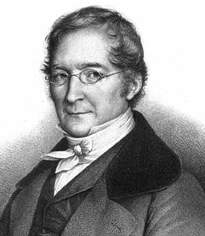- Joseph Louis Gay-Lussac
Infobox Scientist
name = PAGENAME
box_width =
image_size =180px
caption = PAGENAME
birth_date =December 6 ,1778
birth_place =Saint-Léonard-de-Noblat
death_date =May 9 ,1850
death_place =Saint-Léonard-de-Noblat
residence = |citizenship =
nationality = French
ethnicity =
field = chemist
work_institutions =
alma_mater =
doctoral_advisor =
doctoral_students =
known_for =Gay-Lussac's law
author_abbrev_bot =|author_abbrev_zoo =
influences =
influenced =
prizes =
religion = |footnotes = |Joseph Louis Gay-Lussac (also Louis Joseph Gay-Lussac,
December 6 ,1778 –May 9 ,1850 ) was a French chemist and physicist. He is known mostly for two laws related togas es, and for his work on alcohol-water mixtures, which led to thedegrees Gay-Lussac used to measure alcoholic beverages in many countries.Biography
Gay-Lussac was born at
Saint-Léonard-de-Noblat in the department ofHaute-Vienne . He received his early education at home, and in 1794 was sent toParis to prepare for theÉcole Polytechnique after his father was arrested, and into which he was admitted at the end of 1797. Three years later, Gay-Lussac transferred to the École des Ponts et Chaussées, and shortly afterwards was assigned toC. L. Berthollet as his assistant. In 1802, he was appointed demonstrator to A. F. Fourcroy at the École Polytechnique, where in (1809) he became professor of chemistry. From 1808 to 1832, he was professor of physics at the Sorbonne, a post which he only resigned for the chair of chemistry at theJardin des Plantes . In 1831 he was elected to representHaute-Vienne in the chamber of deputies, and in 1839 he entered the chamber of peers.Gay-Lussac married Geneviève-Marie-Joseph Rojot in 1809. He had first met her when she worked as a linen draper's shop assistant and was studying a chemistry textbook under the counter. He fathered five children, of whom the eldest (Jules) became assistant to
Justus Liebig in Giessen. Some publications by Jules are mistaken as his father's today since they share the same first initial (J. Gay-Lussac).Joseph Louis Gay-Lussac died in
Paris , and his grave is there at thePère Lachaise cemetery.Some of Gay-Lussac's descendants live in Brazil, South America (de Salusse Lussac/Lussac Do Coutto/Do Coutto Monni) and in Ontario, Canada.
Achievements
* 1802 - Gay-Lussac first formulated the law stating that if the mass and pressure of a gas are held constant then gas volume increases linearly as the temperature rises. This is sometimes written as V = k T, where k is a constant dependent on the type, mass, and pressure of the gas and T is temperature on an absolute scale. (In terms of the
ideal gas law , k = n R / P.)
* 1804 - He andJean-Baptiste Biot made a hot-air balloon ascent to a height of 6.4 kilometres in an early investigation of theEarth's atmosphere . He wanted to collect samples of the air at different heights to record differences in temperature and moisture.
* 1805 - Together with his friend and scientific collaboratorAlexander von Humboldt , he discovered that the basic composition of the atmosphere does not change with decreasing pressure (increasing altitude). They also discovered that water is formed by two parts of hydrogen and one part of oxygen (by volume).
* 1808 - He was the co-discoverer ofboron .
* 1810 - In collaboration with Louis Thenard, he developed a method for quantitative elemental analysis by measuring the CO2 and O2 evolved by reaction with potassium chlorate.
* 1811 - Gay-Lussac recognizediodine as a new element, described its properties, and suggested the name "iode". [See p. 133 (Appendix 2) of "The Chemical Elements: A Historical Perspective" by Andrew Ede, Greenwood Press, 2006.]
* 1824 - He developed an improved version of theburette that included a side arm, and coined the terms "pipette " and "burette" in an 1824 paper about the standardization of indigo solutions. [Louis Rosenfeld. "Four Centuries of Clinical Chemistry". CRC Press, 1999, p. 72-75.]
* InParis , a street and a hotel near the Sorbonne are named after him as are a square and a street in his birthplace, StLeonard de Noblat .Academic lineage
academia
teachers=C. L. Berthollet (1748-1822), ParisAntoine François, comte de Fourcroy (1755-1809), Parisstudents=
Jean-Jacques Colin (1784-1865), répétiteur in 1809-1817Pierre Robiquet (1780-1840), répétiteur in 1813-1818César Despretz (1791-1863), répétiteur in 1817-?Jules Pelouze (1807-1867), répétiteur in 1831-1837?
Edmé Fremy (1814-1894)Henri-Victor Regnault (1810-1878)Justus Liebig (1803-1873)References
*cite journal
quotes = yes
year=1964 |month=Mar.
title=JOSEPH LOUIS GAY-LUSSAC (1778-1850)--PHYSICIST AND FIRE BALLOONIST
journal=JAMA
volume=187
issue=
pages=771
publisher= |location =UNITED STATES | issn = 0098-7484| pmid = 14094304
bibcode = | oclc =| id = | url = | language = | format = | accessdate = | laysummary = | laysource = | laydate = | quote =
*cite journal
quotes = yes
last=PARTINGTON
first=J R
authorlink=
year=1950 |month=May.
title=J L. Gay-Lussac (1778-1850)
journal=Nature
volume=165
issue=4201
pages=708
publisher= |location =Not Available | issn = 0028-0836| pmid = 15416794
bibcode = | oclc =| id = | url = | language = | format = | accessdate = | laysummary = | laysource = | laydate = | quote =Further reading
* Gay-Lussac, L. J. and A. von Humboldt (1805) "Expérience sur les moyens oediométriques et sur la proportion des principes constituents de l'atmosphère". J. Phys.-Paris LX.
* Maurice Crosland. "Gay-Lussac, Scientist and Bourgeois", Cambridge University Press, Cambridge, 1978, 333p., [http://isbndb.com/ ISBN 0521219795]External links
* [http://www.chemheritage.org/classroom/chemach/gases/gay-lussac.html Biographical material] from the American Chemical Society
Wikimedia Foundation. 2010.
